1. Causes
• Power: To increase Stalin's legitimacy
and authority as Lenin's true successor, raising Stalin's status above other
members of the Party so he became all powerful.
• Politics: To redirect anger for failed
or unpopular policies by transforming Stalin into an icon who transcended
politics.
• Patriotism: To unify the USSR around
loyalty to one leader.
• Paranoia: There is little doubt
that, at least towards the end of his life, Stalin saw plots everywhere.
• Personality Disorder: Did Stalin enjoy, perhaps even need, constant praise?
In 1979, the American historian Robert Tucker wrote:
Although he had won considerable support and even popularity inside party circles during the early post-Lenin years, Stalin never enjoyed a prestige even remotely comparable to Lenin's. His popularity, moreover, plummeted in the early
1930s as a result of forced collectivization and the famine of 1932-33…. So Stalin was undoubtedly concerned to forestall future trouble by making his political supremacy more unassailable…
But, important as it was, the political motive does not provide a sufficient explanation. Not only did the cult continue to grow after Stalin's power became increasingly absolute later in the 1930s, but both direct and indirect evidence indicates that it was a prop for his psyche as well as for his power.
Boundlessly ambitious, yet inwardly insecure, he had an imperative need for hero
worship.
Recently, however, historians Sarah Davies and David Brandenberger have thrown doubt on this
interpretation, citing incidents where Stalin became angry at immoderate praise – for instance,
when he ordered that the sycophantic:
Stories of the Childhood of Stalin (1938) be withdrawn for its
“inexactitudes”.
Plamper found that Stalin “masterminded his own cult”, deliberately imposed it upon writers, artists and officials,
and personally censored books and articles. He suggested that Stalin's modesty was “immodest modesty”, designed ostentatiously to portray himself as above flattery … yet even he includes the story of the time Stalin was furious when he found out that his son was using his
surname to get himself out of trouble:
“But I’m a Stalin too”, argued his son.
“No you’re not”, said Stalin, “You’re not a Stalin and I’m not a Stalin. Stalin is Soviet power. Stalin is what he is in the newspaper and the portraits, not you, not even me!”
... which story gives us, I would suggest, a
significant insight into why Stalin spent so much time and effort developing the
Cult of Stalin.
2. Stalin was portrayed as the 'Vozhd' (supreme leader)
... who was:
a. god-like, omnipresent, omnipotent, infallible;
b. a man of the people working alongside ordinary people;
c. a 'father-figure', caring, yet stern, with the Soviet populace as his
'children';
d. an expert in everything;
e. a great thinker who understood communism and was the true successor of Lenin;
f. when WWII broke out, as the 'Generalissimo', the defender
and saviour of the USSR.
3. How was this achieved?
HHistorians cite the celebration of Stalin's 50th birthday in 1929 as the starting point for his cult of personality. Up to that point, Stalin had chosen to work ‘behind the scenes’ as Party Secretary. Now he assumed a double-billing with Lenin. The famous photo of Stalin sitting with Lenin on a bench was reproduced everywhere. Processions carried banners of Lenin … and, for the first time, of Stalin.
The Soviet press claimed he had been Lenin's constant companion, and that Stalin
was the champion of Lenin's teachings.
1. By 1933, the Soviet Union was covered with his image. In a country where many adults were barely literate,
pictures were vital to conveying the message, and Stalin was shown:
Surrounded by children, or workers, or the people; Dressed in white, or in a grey tunic of a worker; In front of the red flag; Alongside Lenin and Karl Marx; Larger than everybody else, in a pose of authority; often he was the only person in colour; Associated with some great success, such as the Volga Canal, or the Ryon
dam, or meeting with the crew of the ice-breaker Cheliuskin, saved after
their ship sank in the Arctic, or decorating Stakhanovites or Red Army
heroes; During the war, he looked grave and stern-faced; at moments of success he
appeared laughing and jovial.
For Jan Plamper, Dmitry Mochalsky’s 1949 painting: ‘After the demonstration. They saw Stalin.’
represents the consummation of the Cult.
2. Every house contained figurines and pictures of
Stalin, in the way religious Russians venerated icons of the saints; during the
famine in Ukraine 1932-33, it was a saying: “No bread on the table,
Stalin on the wall”.
3. The Soviet press constantly praised Stalin, describing him as "Great", "Beloved", "Bold", "Wise", "Inspirer", and "Genius". From 1936, the Soviet press started to routinely refer to Stalin as the "Father of Nations", "Builder of Socialism", "Architect of Communism", "Leader of Progressive Humanity" etc.
Speeches described Stalin as "Our Best Collective Farm Worker", "Our Best of
Best", and "Our Darling, Our Guiding Star".
4. Even high-ranking ministers joined in the public praise – eg the Commissar for Internal Affairs, Lavrenti Beria, wrote that
Stalin “dominated his entourage with his intelligence”.
Disagreements were kept secret, creating the illusion of undisputed authority.
5. History was re-written: the History of the All-Union Communist Party of Bolsheviks was published in 1938, with significant changes to the historical events that actually took place, emphasising
or inventing Stalin’s decisive actions at critical moments.
As opponents fell out of favour, they were edited out of photographs; in
schools, teachers would go through the history textbooks, pasting new photos
over the top of the images of the purged.
6. Children, especially, featured large in Stalin’s programme. From 1935, the poster: "Thank You Dear Comrade Stalin for a Happy Childhood!" appeared above doorways at nurseries, orphanages, and schools; children also chanted this slogan at festivals. Mothers taught their children that Stalin was ‘the wisest man of the age’.
The cult was spread through the Komsomol, the 'All-Union Leninist Communist
League of Youth' for young people (9-28 years old).
7. By the late 1930s, people would jump out of their seats to stand up whenever Stalin's name was
mentioned in public meetings and conferences.
When a round of applause was called for him, it would regularly continue for at
least quarter of an hour.
8. Numerous towns, villages and cities were renamed
after the Soviet leader.
9. Stalin became the focus of literature, poetry, music, and film that exhibited fawning devotion. An example was Alexander O. Avdeenko's Hymn to Stalin (1935):
Thank you, Stalin. Thank you because I am joyful. Thank you because I am well.
Centuries will pass, and the generations still to come will regard us as the
happiest of mortals, as the most fortunate of men… because we were privileged to
see Stalin, our inspired leader ...
Everything belongs to you, chief of our great country.
And when the woman I love presents me with a child the first word it shall utter
will be: Stalin.
O great Stalin, O leader of the peoples,
You brought man to birth.
You make the earth fruitful,
You restore the centuries,
You cause the spring to bloom,
and music to play.
You, splendour of my spring,
O thou sun reflected by millions
of hearts.
During World War II, Stalin's name
was included
in the new Soviet national anthem.
10. Censorship:
The function of state censorship under Stalin was to ensure ‘Soviet Realism’ (an idealised representation of life under socialism).
Books and newspapers were censored by Glavlit, the Directorate for the Protection of State Secrets. To be published, a book had to be accepted by a state-owned publishing house. Possession of an unauthorised book was a crime.
Purged people were erased from photographs (e.g. Trotsky). Stalin personally acted as chief censor for films; he made so many suggestions for the film
The Great Citizen (about the Moscow show trials) that it had to be completely rewritten. When
The Law of Life depicted a Komsomol leader in a bad light, the film was banned and the director put on trial. Foreign radio stations were jammed.
Why was the Cult of Stalin so successful?
There are a number of possibilities:
1. Emotional Investment?
The historian Sheila Fitzpatrick suggests that many
Soviet citizens, especially workers and younger people, had invested so much
effort in the revolutionary project that they were emotionally invested’ – they
wanted to believe that Stalin was guiding them to a socialist utopia.
2. Political Religion?
Although Graeme Gill (2021) stresses that there was
much about the Cult of Stalin which was very UNlike a religion’, he accepts that
“there are aspects of the leader cult and its realisation that bear close
comparison with religion” (as does Anita Pisch, 2016). The Russian people’s
religious faith in God, and the Tsar as their 'Father', morphed easily into revering Stalin as an
infallible, omnipotent figure.
3. Need for Stability?
The famous historian Orlando Figes argues that, after
years of war, famine, and social upheaval, many people craved order and
stability, “millions of people looked to Stalin as a protector from injustice
and the embodiment of all their hopes”.
4. Soviet Social Contract?
5. Cognitive Dissonance?
6. National Pride and External Enemies?
7. Susceptibility?
As Jan Plamper points out, all this persuasive propaganda technology was brand new, and until 1918 most of its recipients were illiterate and knew nothing beyond the
mir.
They were not trained in bullshit-recognition to the same extent people are
today.
|

Stalin (right) with Lenin on a bench – the photo that launched the Cult of Stalin.
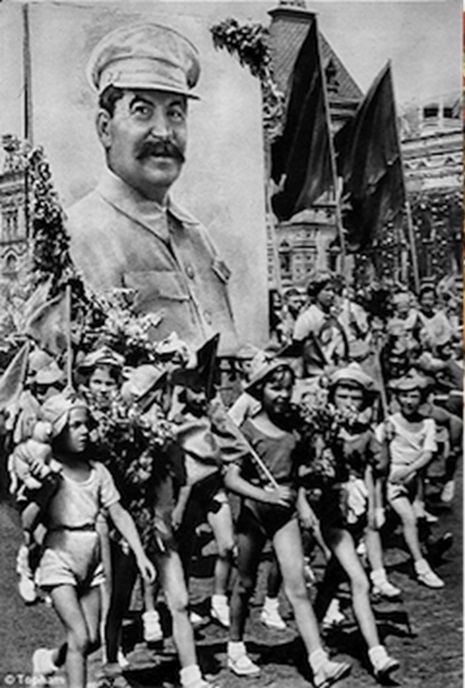
Stalin's birthday celebrations..
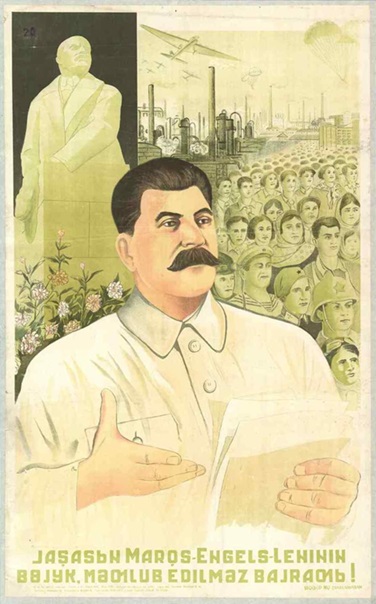
The reality of our program is living people, you and I'

'Glory [or Love] to Great Stalin!' in Azerbaijani, then in Russian.
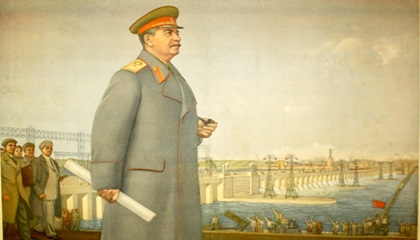
'All hail Stalin, the great architect of communism'; Stalin
inspects the Volga Canal (1935).

Stalin at the hydro-electric dam at Ryon in the Caucasus
(1935).
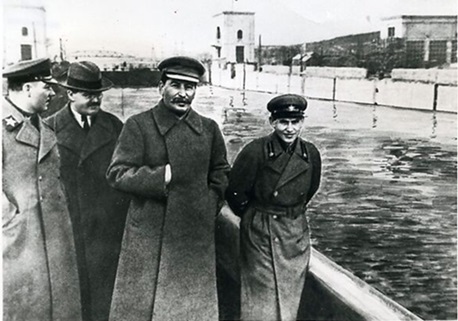
A photo from 1937 of Stalin visiting the Volga Canal in 1935. The man to his left is Nikolay Yezhov, the NKVD chief who conducted the Great Purges (the Yezhovshchina), but was disgraced in 1939 and executed in 1940.
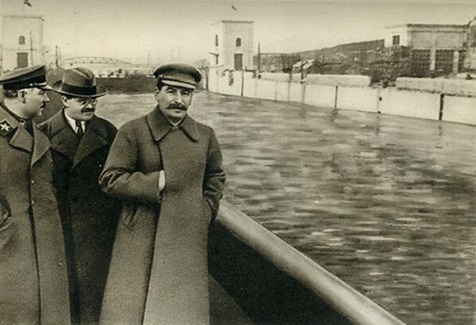
A 1940 photo of Stalin visiting the Volga Canal in 1935.
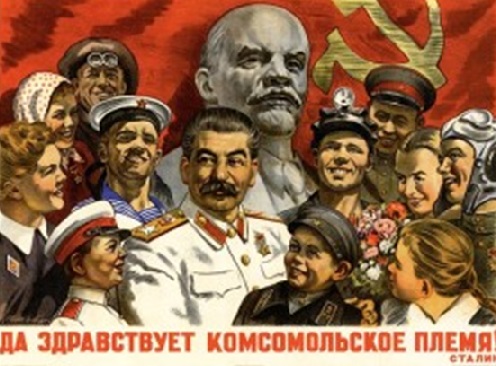
'Long live the Komsomol generation! Stalin' (1948)
Consider:
1. Explain why the story of Stalin's argument with his son
"gives us a significant insight" into why he developed the Cult of Stalin.
2. Study the ways Stalin was portrayed
(2.a-f); for each, suggest the kind of person it would appeal to.
3. Repeat the same exercise for the ways
Stalin was depicted in paintings (3.1).
4. Study the paintings and posters; explain
their imagery and impact.
5. Why, do you think, was the Cult of Stalin so successful?
|